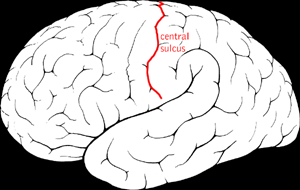Rolandic epilepsy
| Rolandic epilepsy | |
|---|---|
 |
|
| Diagram showing the central sulcus of the brain. | |
| Classification and external resources | |
| Specialty | neurology |
| ICD-10 | G40.0 |
| OMIM | 117100 |
| DiseasesDB | 33998 |
| eMedicine | neuro/641 |
| MeSH | D019305 |
Benign Rolandic epilepsy or benign childhood epilepsy with centrotemporal spikes (BCECTS) is the most common epilepsy syndrome in childhood. Most children will outgrow the syndrome (it starts around the age of 3-13 with a peak around 8–9 years and stops around age 14-18), hence the label benign. The seizures, sometimes referred to as sylvian seizures, start around the central sulcus of the brain (also called the centrotemporal area, located around the Rolandic fissure, after Luigi Rolando).
The cardinal features of Rolandic epilepsy are infrequent, often single, focal seizures consisting of:
Hemifacial sensorimotor seizures are often entirely localised in the lower lip or spread to the ipsilateral hand. Motor manifestations are sudden, continuous or bursts of clonic contractions, usually lasting from a few seconds to a minute. Ipsilateral tonic deviation of the mouth is also common. Hemifacial sensory symptoms consist of unilateral numbness mainly in the corner of the mouth. Hemifacial seizures are often associated with an inability to speak and hypersalivation: The left side of my mouth felt numb and started jerking and pulling to the left, and I could not speak to say what was happening to me. Negative myoclonus can be observed in some cases, as an interruption of tonic muscular activity
Oropharyngolaryngeal ictal manifestations are unilateral sensorimotor symptoms inside the mouth. Numbness, and more commonly paraesthesias (tingling, prickling, freezing), are usually diffuse on one side or, exceptionally, may be highly localised even to one tooth. Motor oropharyngolaryngeal symptoms produce strange sounds, such as death rattle, gargling, grunting and guttural sounds, and combinations: In his sleep, he was making guttural noises, with his mouth pulled to the right, ‘as if he was chewing his tongue’. We heard her making strange noises ‘like roaring’ and found her unresponsive, head raised from the pillow, eyes wide open, rivers of saliva coming out of her mouth, rigid.
Arrest of speech is a form of anarthria. The child is unable to utter a single intelligible word and attempts to communicate with gestures. My mouth opened and I could not speak. I wanted to say I cannot speak. At the same time, it was as if somebody was strangling me.
Hypersalivation , a prominent autonomic manifestation, is often associated with hemifacial seizures, oro-pharyngo-laryngeal symptoms and speech arrest. Hypersalivation is not just frothing: Suddenly my mouth is full of saliva, it runs out like a river and I cannot speak.
...
Wikipedia
